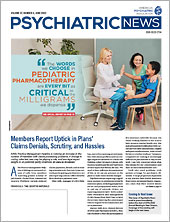APA Urges Members to Ask Representatives to Cosponsor Parity Implementation Assistance Act
APA is encouraging its members to ask their Congressional representatives and senators to cosponsor the Parity Implementation Assistance Act (HR 3753/S 1962) and support granting the U.S. Department of Labor (DOL) the ability to levy monetary penalties against health plans that are not in compliance with the federal parity law.
The bipartisan, bicameral legislation would authorize $25 million annually to help state insurance departments step up parity enforcement. A report issued earlier this year from the DOL showed that many health plans are out of compliance with the Mental Health Parity and Addiction Equity Act (MHPAEA) (“
Government Steps Up Efforts to Enforce Parity Law”).
Additionally, APA sent a letter to Sens. Chris Murphy (D-Conn.) and Bill Cassidy (R-La.) to thank them for their leadership in helping to strengthen compliance with MHPAEA. Four similar letters were sent to champions of parity in the House: Reps. Tony Cárdenas (D-Calif.), Gus Bilirakis (R-Fla.), Katie Porter (D-Calif.), and Brian Fitzpatrick (R-Pa.).
APA Requests Funds for Parity Enforcement, Evidence-Based Mental Health Programs
APA requested greater resources for federal agencies to enforce the federal parity law in a letter to a subcommittee of the House Committee on Appropriations regarding fiscal year 2023 funding. The letter was addressed to Reps. Rosa DeLauro (D-Conn.) and Tom Cole (R-Okla.), chair and ranking member, respectively, of the Subcommittee on Labor, Health and Human Services, Education, and Related Agencies.
In the letter, signed by APA CEO and Medical Director Saul Levin, M.D., M.P.A., APA requested $27.5 million for parity compliance resources for DOL’s Employee Benefits Security Administration (EBSA), as well as $25 million for the Centers for Medicare and Medicaid Services (CMS). The CMS funds would provide grants to states to enforce parity at the state level. “These federal and state agencies need resources to enforce the law and hold plans accountable when they are not in compliance,” the letter states.
APA also requested that the subcommittee take the following actions:
•
Increase funding for the Substance Abuse and Mental Health Services Administration “to implement and sustain evidence-based programs that provide delivery and financing of prevention, treatment, and recovery services” for people experiencing mental health and substance use disorders.
•
Prioritize workforce-building programs administered by the Health Resources and Services Administration, such as the Loan Repayment Program for Substance Use Disorder Treatment Workforce and the Mental and Substance Use Disorder Workforce Training Demonstration Program.
•
Increase funding for other federal agencies, including the National Institutes of Health, the Centers for Disease Control and Prevention (CDC), and the Agency for Healthcare Research and Quality.
“It is vital that as you consider funding levels for the coming fiscal year, you continue to invest in programs that support the delivery of high-quality, evidence-based [mental health and substance use disorder] services,” wrote Levin.
APA Holds Bipartisan 988 Briefing With House Energy and Commerce Staff
APA partnered with the National Association of State Mental Health Program Directors and the National Association of Counties to provide a briefing for House Energy and Commerce majority and minority staff on the forthcoming launch of 988, the new three-digit dialing code for the National Suicide and Crisis Lifeline.
The briefing included Carrie Slatton-Hodges, commissioner of the Oklahoma Department of Mental Health and Substance Use, as well as representatives from each organization. The focus was on state and local government needs in strengthening crisis services to support the launch of 988 in July. APA representatives expressed the organization’s commitment to continue working with stakeholders to support the 988 launch and to expand access to the full continuum of mental health crisis services.
APA Comments on CDC’s Opioid Prescribing Guidelines Draft
APA provided comments and recommendations to the CDC in response to the agency’s proposed guidelines for prescribing opioids.
In the letter, APA noted that the agency’s proposed guidelines are, overall, an improvement compared with those issued in 2016. “The 2022 draft intends to apply to acute, subacute, and chronic pain, whereas the 2016 guideline intended only to address chronic pain, and the inclusion of all types of pain is a notable improvement,” the letter stated.
Additionally, the letter outlined concerns APA has regarding “the guideline’s heavy emphasis towards tapering, which can destabilize many patients.” It continued: “If a patient with chronic pain is well controlled at a particular dosage of opioid medication, is tolerating that dosage well, shows functional improvement, and does not wish to reduce the dosage, [he or she] should be maintained at the present dosage.”
Further, APA requested some additional changes to the guidelines, including a greater emphasis on psychotherapy and clarifying the recommendations concerning medications to treat opioid use disorder. ■
